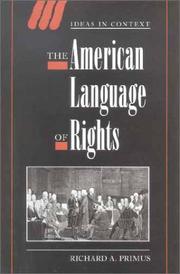| Listing 1 - 8 of 8 |
Sort by
|
Book
Year: 1959
Abstract | Keywords | Export | Availability | Bookmark
 Loading...
Loading...Choose an application
- Reference Manager
- EndNote
- RefWorks (Direct export to RefWorks)
Book
ISBN: 3770524896 Year: 1987 Publisher: München : Wilhelm Fink,
Abstract | Keywords | Export | Availability | Bookmark
 Loading...
Loading...Choose an application
- Reference Manager
- EndNote
- RefWorks (Direct export to RefWorks)
Book
Year: 1963
Abstract | Keywords | Export | Availability | Bookmark
 Loading...
Loading...Choose an application
- Reference Manager
- EndNote
- RefWorks (Direct export to RefWorks)
Book
ISBN: 3896782886 9783896782885 Year: 2006 Publisher: Darmstadt Primus Verlag
Abstract | Keywords | Export | Availability | Bookmark
 Loading...
Loading...Choose an application
- Reference Manager
- EndNote
- RefWorks (Direct export to RefWorks)
Hohenstaufen, House of --- Germany --- History --- Hohenstaufen (maison de) --- Saint Empire romain germanique --- Dictionnaires allemands --- 1138-1254 (Hohenstaufen) --- Dictionnaires

ISBN: 0521652502 0521616212 110711747X 0511172036 0511149883 0511324561 0511490690 1280420685 0511048262 0511006292 9780511006296 0511033036 9780511033032 9780511149887 9780511048265 9780521652506 9780511490699 9780521616218 Year: 1999 Volume: 54 Publisher: Cambridge, U.K. ; New York : Cambridge University Press,
Abstract | Keywords | Export | Availability | Bookmark
 Loading...
Loading...Choose an application
- Reference Manager
- EndNote
- RefWorks (Direct export to RefWorks)
Richard A. Primus examines three crucial periods in American history (the late eighteenth century, the civil war and the 1950s and 1960s) in order to demonstrate how the conceptions of rights prevailing at each of these times grew out of reactions to contemporary social and political crises. His innovative approach sees rights language as grounded more in opposition to concrete social and political practices, than in the universalistic paradigms presented by many political philosophers. This study demonstrates the potency of the language of rights throughout American history, and looks for the first time at the impact of modern totalitarianism (in Nazi Germany and the Soviet Union) on American conceptions of rights. The American Language of Rights is a major contribution to contemporary political theory, of interest to scholars and students in politics and government, constitutional law, and American history.
Civil rights --- Critical legal studies --- Human rights --- Philosophy. --- Language. --- United States --- Philosophy --- Language --- Arts and Humanities --- History --- DROITS CIVILS ET POLITIQUES --- ETUDE CIVIQUE DU DROIT --- DROITS DE L'HOMME --- PHILOSOPHIE --- ETATS-UNIS --- LANGAGE
Book
ISBN: 9783847104940 Year: 2016 Publisher: Göttingen : V&R unipress,
Abstract | Keywords | Export | Availability | Bookmark
 Loading...
Loading...Choose an application
- Reference Manager
- EndNote
- RefWorks (Direct export to RefWorks)
Book
ISBN: 9783631766415 Year: 2019 Publisher: Peter Lang AG
Abstract | Keywords | Export | Availability | Bookmark
 Loading...
Loading...Choose an application
- Reference Manager
- EndNote
- RefWorks (Direct export to RefWorks)
The book focuses on the reception relations of Soviet Russian art, culture and literature in Austria from 1918 to 1938. It shows their resonance, locating it in discourses typical of the time such as activism, New Objectivity, avantgarde of theatre and music, but also contemporary American discourse.
Book
Year: 2019 Publisher: Frankfurt a.M. PH02
Abstract | Keywords | Export | Availability | Bookmark
 Loading...
Loading...Choose an application
- Reference Manager
- EndNote
- RefWorks (Direct export to RefWorks)
Die Oktoberrevolution von 1917 und die Gründung der Sowjetunion zog politisch-ideologisch wie kulturell-künstlerisch im deutschsprachigen Raum hohe Aufmerksamkeit auf sich und polarisierte die intellektuelle Öffentlichkeit. Insbesondere in der Ersten Republik bzw. im ›Roten Wien‹ stießen manche ihrer Impulse auf Resonanz, andere auf dezidierte Zurückweisung. Auch im bürgerlichen Kunst- und Literaturbetrieb, zum Beispiel dem der Musik, des Theaters oder des Films wurden (sowjet)russische Entwicklungen wahrgenommen und diskutiert. Der Band widmet sich solchen Rezeptionsbeziehungen, arbeitet ihre zum Teil erstaunliche Resonanz heraus, verortet sie in zeittypischen Diskursen wie dem des Aktivismus, der Theater- und Musikavantgarde, aber auch, kontrastierend-komplementär, dem des zeitgenössischen Amerika-Diskurses.
›Roten --- 1918-1938 --- Alexandra --- etal --- Heinz --- Kucher --- Kultur --- Kunst --- lange --- Literatur --- Marciniak --- Musik- und Filmavantgarde --- Oktober‹ --- Österreich --- Österreichisch-Russische Kultur-, Literatur- und Kunstbeziehungen --- Primus --- Proletkult und Konstruktivismus --- Rebecca --- Relevanz --- Rezeption --- russischer --- Russland --- Russland - Amerika --- Russland in der feuilletonistischen Publizistik --- Russland-Reisebilder --- Schatten --- Simonek --- sowjet --- Stefan --- Unterberger
| Listing 1 - 8 of 8 |
Sort by
|

 Search
Search Feedback
Feedback About UniCat
About UniCat  Help
Help News
News